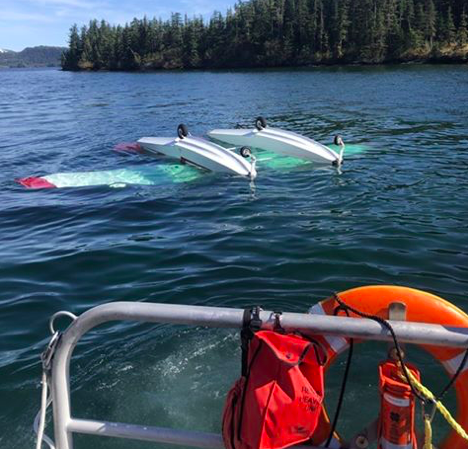The crash of an amphibious plane in Prince William Sound left one passenger dead, and pilots around Alaska scratching their heads: Why were the wheels down on the plane, as shown in the photo provided by the U.S. Coast Guard? Should they not have been retracted?
The Cessna A185F crashed in Cascade Bay, between Whittier and Valdez in Prince William Sound. The pilot, Scott Johannes of Wasilla, was attempting to land on the bay but was unsuccessful, according to the U.S. Coast Guard. 75-year-old Dr. William Resinger of Palmer died after being trapped in the plane, which had flipped. The pilot and the other passenger escaped; all three were retrieved by good Samaritan boaters in the area.
The report came into the Coast Guard at 2 pm on Tuesday, stating that a Cessna A185F Skywagon had crashed. Two Coast Guard boats responded and transported the occupants to medical facilities.
Amphibious planes have wheels that retract and the planes can land on an airstrip or in the water. The Cessna 185 Skywagon seats six and can be fitted with floats, amphibious floats or skis.
It’s been a rough May in Alaska’s tight-knit aviation community. Six people died in a mid-air collision in Ketchikan on May 13, and two people died when a floatplane cartwheeled in the water near Metlakatla on Monday. The Cascade Bay crash on Tuesday brings the death toll to 9 in the span of eight days.

The wheels on the floats appear to not have been retracted after take off from a land based strip. When retracted, the front wheels come forward and up, and rotate to a rest on top of the floats, with the amphibious configuration for regular float planes . The rear wheels retract into a divot directly behind where you see them in the picture. Probably the most common cause of amphibious float plane crashes upon landing in the water. A Grumman Goose is a twin engine amphibian with a mono hull configuration and the wheels retract into the side of the mono hull. The Goose has struts toward the ends of the wings, with small pontoons on them, to stabilize the plane at low speed in the water. I’m not an expert by any means, but I am a float plane pilot with over 2,000 hours logged on floats.
Extended landing gear on floats + water landing = nose-over flip, everytime… so sorry for all involved.
I’d be curious to see a study on the safety of pilots for religious groups such as this one is.
Here is one of the classic missionary flight groups for reference:
https://www.jaars.org/
My husband (a professional pilot) and I know many pilots who are either on the mission field or training to go there. They have to get all the same licenses, hours, certifications, and ratings any other commercial pilot does, and they have to pass other bars besides, because most of them are going to be operating in comparatively primitive areas with short dirt landing strips and poor infrastructure. Most of them also have to be mechanics and able to fix their airplanes in the field without the usual support of a full workshop. In other words, they have to be really good at what they do. Alaska is actually known as a training destination for would-be missionary pilots, because many of our remote areas offer comparable situations to what they will encounter—rapidly changing weather conditions, little to no flight services, short-field landings and takeoffs.
I’m not saying this pilot was a trained missionary pilot; I don’t know. But as with any other crash, the fair and respectful thing to do is to wait for the full NTSB investigation before speculating too much.
They pass the same tests and check rides that any other pilot passes to get commercial certifications. I don’t see how it being a religious group has any bearing. A bigger factor is usually operators pushing to get flights done fast in order to take more passengers, or people pushing in bad weather to get flights done.
A semi-common mistake with amphibious aircraft. After a long winter of only landing on wheels, the pilot forgets to retract the gear after a “land”-runway takeoff… OR… they actually extend the landing gear prior to landing on the water since they have been in the habit of pre-landing gear extension all winter long. Pilots involved in such accidents seldom admit to either one. Particularly when a n injury or death is involved. When I mention amphibious floats to my aircraft insurance broker, they need to fire up their special price calculator with an extra digit. This most recent series of accidents will increase the Alaskan aircraft insurance premiums even further. This year a major underwriter pulled out of the Alaskan market.